Health Promotion Model in Practice: A Comprehensive Overview
VerifiedAdded on 2022/11/30
|6
|1206
|314
Report
AI Summary
This report provides a comprehensive overview of the Health Promotion Model (HPM), exploring its definition, assumptions, and operational application within healthcare settings. It emphasizes the importance of patient education, support mechanisms, and counseling in empowering individuals to adopt healthy lifestyle choices. The report delves into Jean Watson's theory of caring, highlighting its significance in fostering strong therapeutic relationships between healthcare professionals and patients. It discusses the practical implications of HPM, including its influence on health promotion strategies, disease prevention, and the promotion of individual well-being. Furthermore, the report examines the theoretical underpinnings of HPM and addresses potential practice questions related to its effectiveness and implementation. The conclusion underscores the importance of HPM in enhancing patient-centered care and promoting positive health outcomes. The report also includes references to key literature in the field.
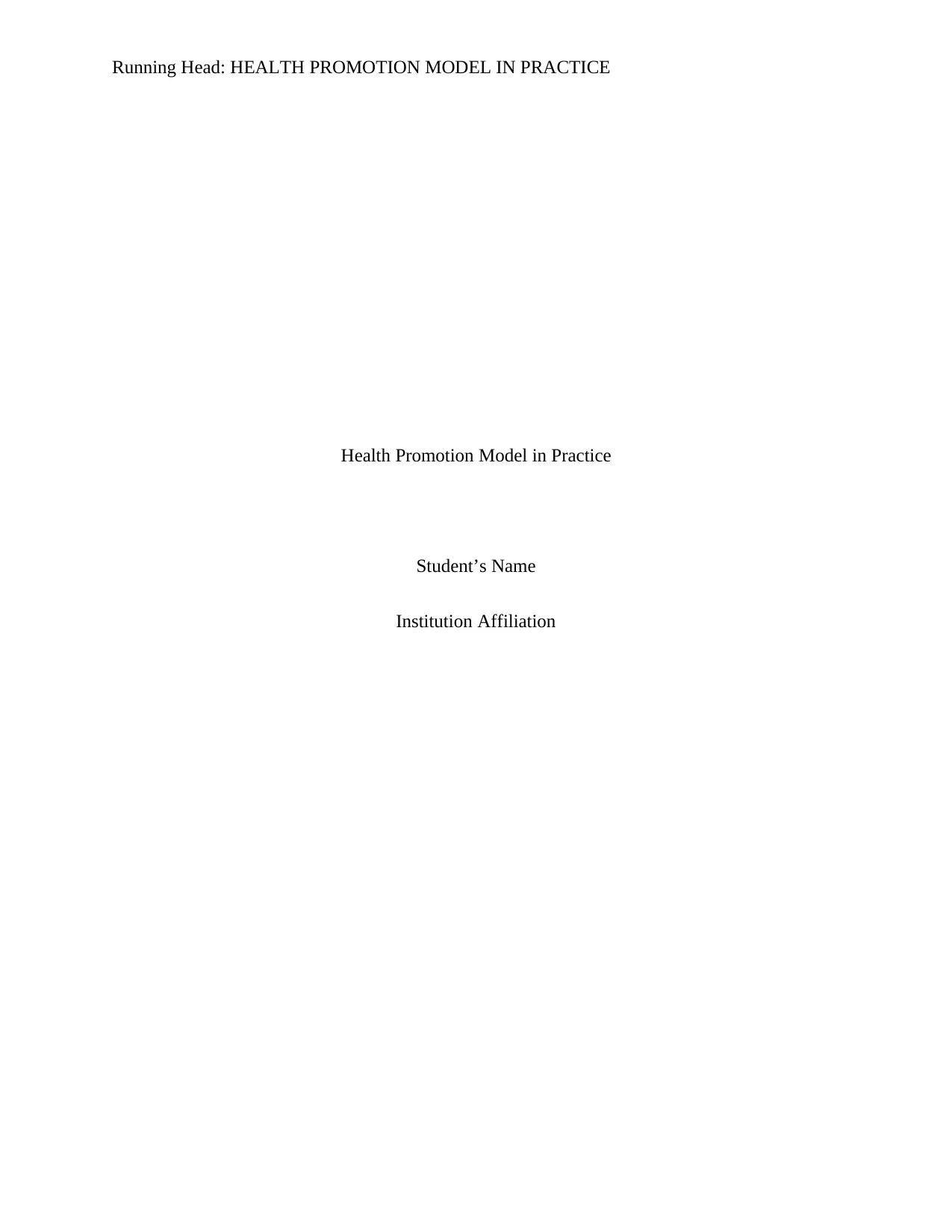
Running Head: HEALTH PROMOTION MODEL IN PRACTICE
Health Promotion Model in Practice
Student’s Name
Institution Affiliation
Health Promotion Model in Practice
Student’s Name
Institution Affiliation
Paraphrase This Document
Need a fresh take? Get an instant paraphrase of this document with our AI Paraphraser
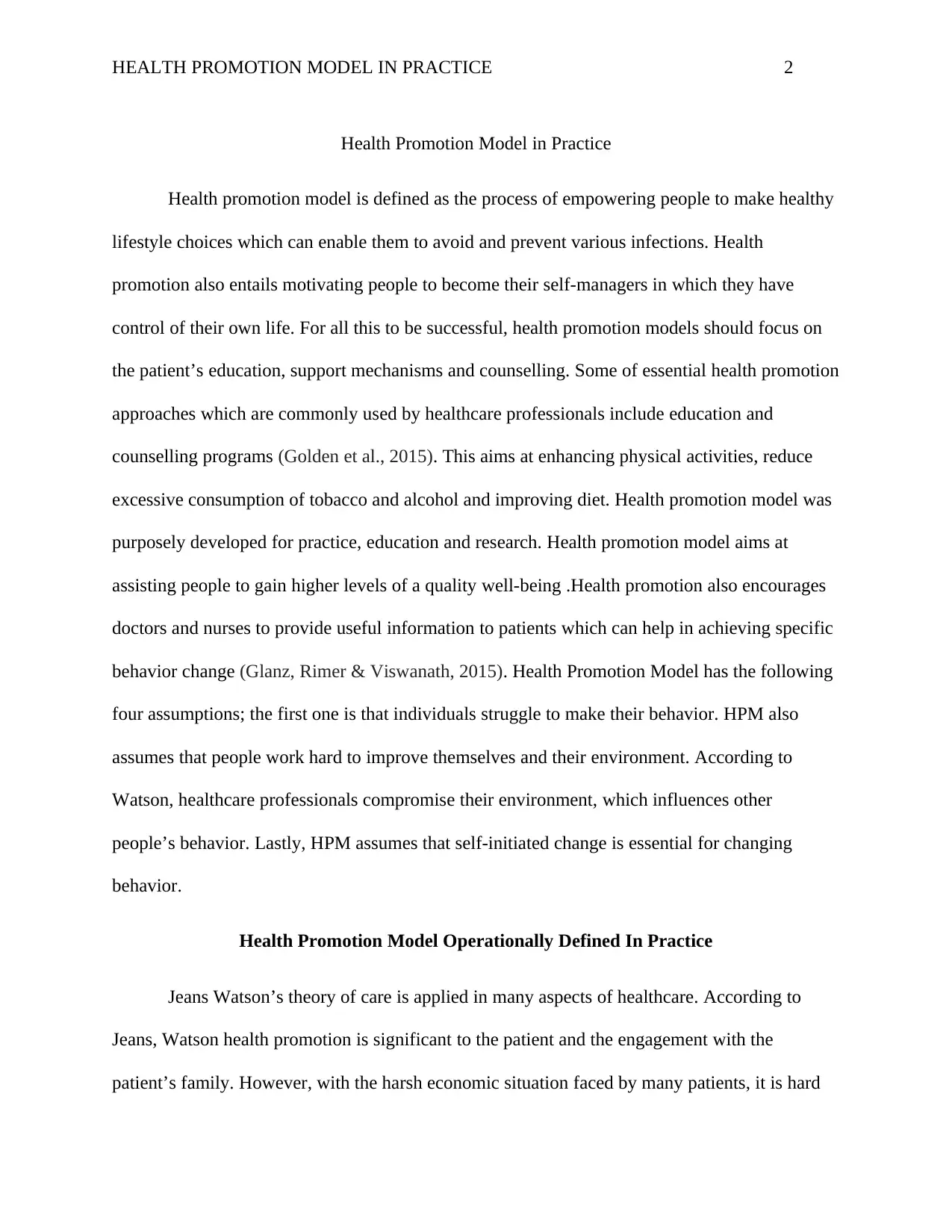
HEALTH PROMOTION MODEL IN PRACTICE 2
Health Promotion Model in Practice
Health promotion model is defined as the process of empowering people to make healthy
lifestyle choices which can enable them to avoid and prevent various infections. Health
promotion also entails motivating people to become their self-managers in which they have
control of their own life. For all this to be successful, health promotion models should focus on
the patient’s education, support mechanisms and counselling. Some of essential health promotion
approaches which are commonly used by healthcare professionals include education and
counselling programs (Golden et al., 2015). This aims at enhancing physical activities, reduce
excessive consumption of tobacco and alcohol and improving diet. Health promotion model was
purposely developed for practice, education and research. Health promotion model aims at
assisting people to gain higher levels of a quality well-being .Health promotion also encourages
doctors and nurses to provide useful information to patients which can help in achieving specific
behavior change (Glanz, Rimer & Viswanath, 2015). Health Promotion Model has the following
four assumptions; the first one is that individuals struggle to make their behavior. HPM also
assumes that people work hard to improve themselves and their environment. According to
Watson, healthcare professionals compromise their environment, which influences other
people’s behavior. Lastly, HPM assumes that self-initiated change is essential for changing
behavior.
Health Promotion Model Operationally Defined In Practice
Jeans Watson’s theory of care is applied in many aspects of healthcare. According to
Jeans, Watson health promotion is significant to the patient and the engagement with the
patient’s family. However, with the harsh economic situation faced by many patients, it is hard
Health Promotion Model in Practice
Health promotion model is defined as the process of empowering people to make healthy
lifestyle choices which can enable them to avoid and prevent various infections. Health
promotion also entails motivating people to become their self-managers in which they have
control of their own life. For all this to be successful, health promotion models should focus on
the patient’s education, support mechanisms and counselling. Some of essential health promotion
approaches which are commonly used by healthcare professionals include education and
counselling programs (Golden et al., 2015). This aims at enhancing physical activities, reduce
excessive consumption of tobacco and alcohol and improving diet. Health promotion model was
purposely developed for practice, education and research. Health promotion model aims at
assisting people to gain higher levels of a quality well-being .Health promotion also encourages
doctors and nurses to provide useful information to patients which can help in achieving specific
behavior change (Glanz, Rimer & Viswanath, 2015). Health Promotion Model has the following
four assumptions; the first one is that individuals struggle to make their behavior. HPM also
assumes that people work hard to improve themselves and their environment. According to
Watson, healthcare professionals compromise their environment, which influences other
people’s behavior. Lastly, HPM assumes that self-initiated change is essential for changing
behavior.
Health Promotion Model Operationally Defined In Practice
Jeans Watson’s theory of care is applied in many aspects of healthcare. According to
Jeans, Watson health promotion is significant to the patient and the engagement with the
patient’s family. However, with the harsh economic situation faced by many patients, it is hard
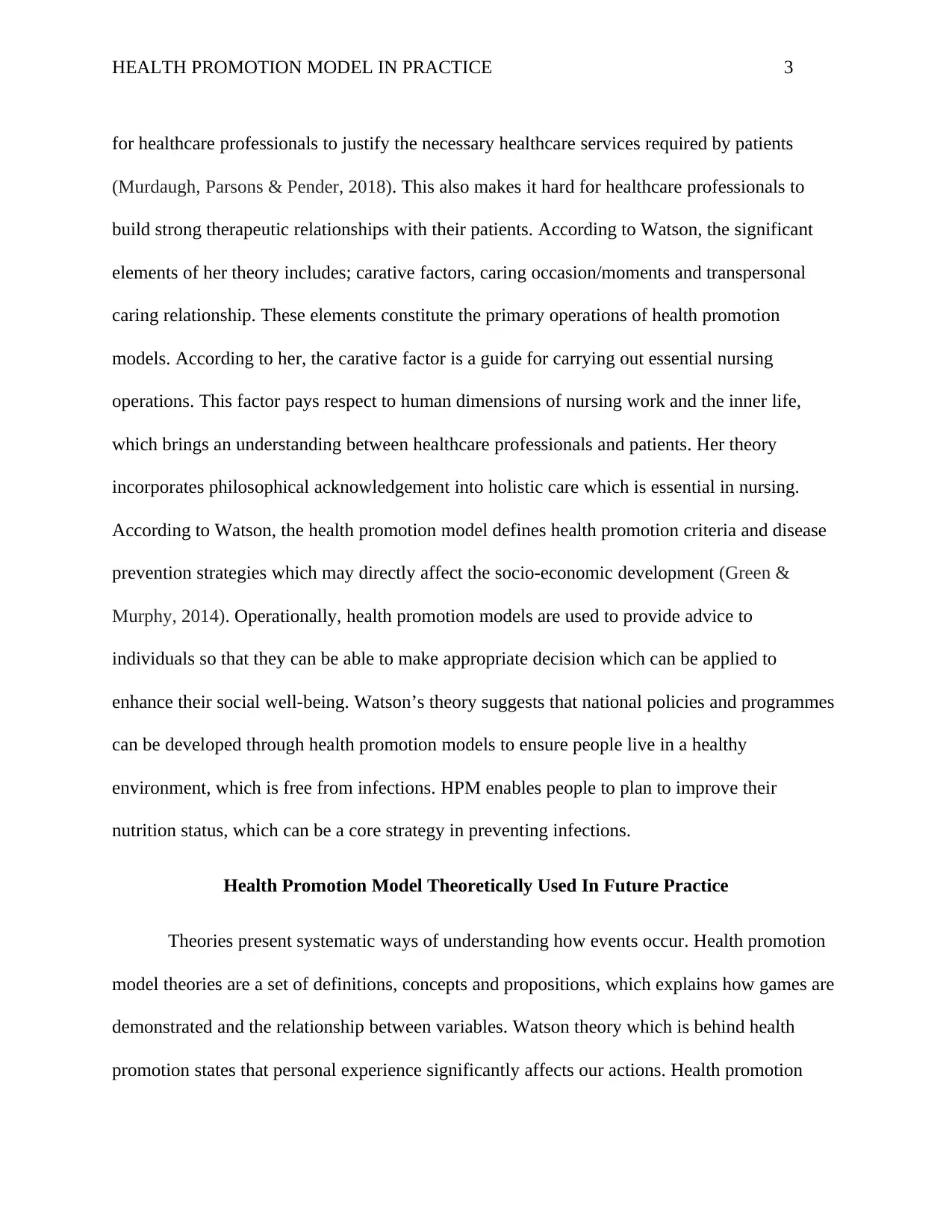
HEALTH PROMOTION MODEL IN PRACTICE 3
for healthcare professionals to justify the necessary healthcare services required by patients
(Murdaugh, Parsons & Pender, 2018). This also makes it hard for healthcare professionals to
build strong therapeutic relationships with their patients. According to Watson, the significant
elements of her theory includes; carative factors, caring occasion/moments and transpersonal
caring relationship. These elements constitute the primary operations of health promotion
models. According to her, the carative factor is a guide for carrying out essential nursing
operations. This factor pays respect to human dimensions of nursing work and the inner life,
which brings an understanding between healthcare professionals and patients. Her theory
incorporates philosophical acknowledgement into holistic care which is essential in nursing.
According to Watson, the health promotion model defines health promotion criteria and disease
prevention strategies which may directly affect the socio-economic development (Green &
Murphy, 2014). Operationally, health promotion models are used to provide advice to
individuals so that they can be able to make appropriate decision which can be applied to
enhance their social well-being. Watson’s theory suggests that national policies and programmes
can be developed through health promotion models to ensure people live in a healthy
environment, which is free from infections. HPM enables people to plan to improve their
nutrition status, which can be a core strategy in preventing infections.
Health Promotion Model Theoretically Used In Future Practice
Theories present systematic ways of understanding how events occur. Health promotion
model theories are a set of definitions, concepts and propositions, which explains how games are
demonstrated and the relationship between variables. Watson theory which is behind health
promotion states that personal experience significantly affects our actions. Health promotion
for healthcare professionals to justify the necessary healthcare services required by patients
(Murdaugh, Parsons & Pender, 2018). This also makes it hard for healthcare professionals to
build strong therapeutic relationships with their patients. According to Watson, the significant
elements of her theory includes; carative factors, caring occasion/moments and transpersonal
caring relationship. These elements constitute the primary operations of health promotion
models. According to her, the carative factor is a guide for carrying out essential nursing
operations. This factor pays respect to human dimensions of nursing work and the inner life,
which brings an understanding between healthcare professionals and patients. Her theory
incorporates philosophical acknowledgement into holistic care which is essential in nursing.
According to Watson, the health promotion model defines health promotion criteria and disease
prevention strategies which may directly affect the socio-economic development (Green &
Murphy, 2014). Operationally, health promotion models are used to provide advice to
individuals so that they can be able to make appropriate decision which can be applied to
enhance their social well-being. Watson’s theory suggests that national policies and programmes
can be developed through health promotion models to ensure people live in a healthy
environment, which is free from infections. HPM enables people to plan to improve their
nutrition status, which can be a core strategy in preventing infections.
Health Promotion Model Theoretically Used In Future Practice
Theories present systematic ways of understanding how events occur. Health promotion
model theories are a set of definitions, concepts and propositions, which explains how games are
demonstrated and the relationship between variables. Watson theory which is behind health
promotion states that personal experience significantly affects our actions. Health promotion
⊘ This is a preview!⊘
Do you want full access?
Subscribe today to unlock all pages.

Trusted by 1+ million students worldwide
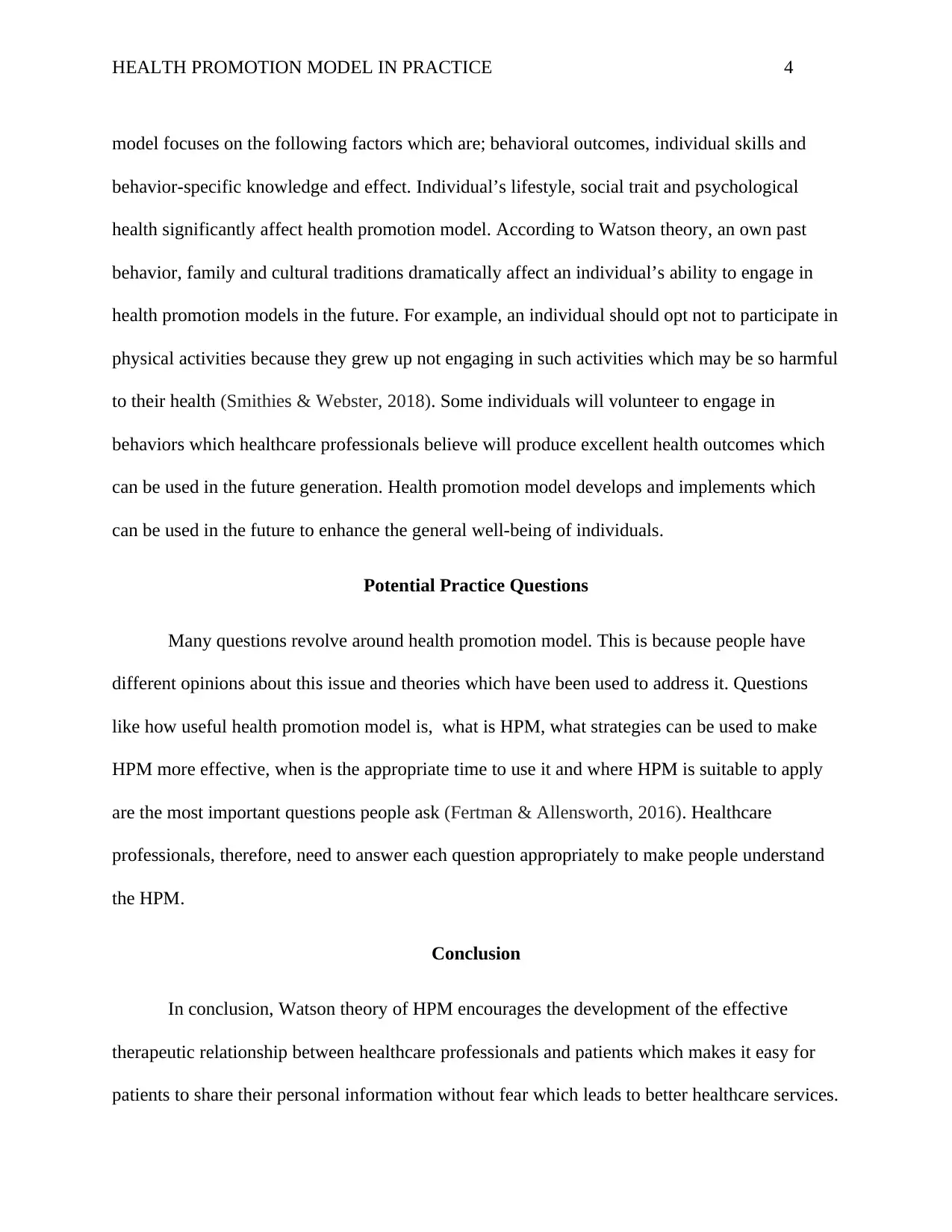
HEALTH PROMOTION MODEL IN PRACTICE 4
model focuses on the following factors which are; behavioral outcomes, individual skills and
behavior-specific knowledge and effect. Individual’s lifestyle, social trait and psychological
health significantly affect health promotion model. According to Watson theory, an own past
behavior, family and cultural traditions dramatically affect an individual’s ability to engage in
health promotion models in the future. For example, an individual should opt not to participate in
physical activities because they grew up not engaging in such activities which may be so harmful
to their health (Smithies & Webster, 2018). Some individuals will volunteer to engage in
behaviors which healthcare professionals believe will produce excellent health outcomes which
can be used in the future generation. Health promotion model develops and implements which
can be used in the future to enhance the general well-being of individuals.
Potential Practice Questions
Many questions revolve around health promotion model. This is because people have
different opinions about this issue and theories which have been used to address it. Questions
like how useful health promotion model is, what is HPM, what strategies can be used to make
HPM more effective, when is the appropriate time to use it and where HPM is suitable to apply
are the most important questions people ask (Fertman & Allensworth, 2016). Healthcare
professionals, therefore, need to answer each question appropriately to make people understand
the HPM.
Conclusion
In conclusion, Watson theory of HPM encourages the development of the effective
therapeutic relationship between healthcare professionals and patients which makes it easy for
patients to share their personal information without fear which leads to better healthcare services.
model focuses on the following factors which are; behavioral outcomes, individual skills and
behavior-specific knowledge and effect. Individual’s lifestyle, social trait and psychological
health significantly affect health promotion model. According to Watson theory, an own past
behavior, family and cultural traditions dramatically affect an individual’s ability to engage in
health promotion models in the future. For example, an individual should opt not to participate in
physical activities because they grew up not engaging in such activities which may be so harmful
to their health (Smithies & Webster, 2018). Some individuals will volunteer to engage in
behaviors which healthcare professionals believe will produce excellent health outcomes which
can be used in the future generation. Health promotion model develops and implements which
can be used in the future to enhance the general well-being of individuals.
Potential Practice Questions
Many questions revolve around health promotion model. This is because people have
different opinions about this issue and theories which have been used to address it. Questions
like how useful health promotion model is, what is HPM, what strategies can be used to make
HPM more effective, when is the appropriate time to use it and where HPM is suitable to apply
are the most important questions people ask (Fertman & Allensworth, 2016). Healthcare
professionals, therefore, need to answer each question appropriately to make people understand
the HPM.
Conclusion
In conclusion, Watson theory of HPM encourages the development of the effective
therapeutic relationship between healthcare professionals and patients which makes it easy for
patients to share their personal information without fear which leads to better healthcare services.
Paraphrase This Document
Need a fresh take? Get an instant paraphrase of this document with our AI Paraphraser

HEALTH PROMOTION MODEL IN PRACTICE 5
Various studies which have been carried out indicate that both healthcare professional and the
patient benefits from this kind of relationship. It is also significant to encourage health promotion
to make individuals managers of their own lives by making the appropriate decisions.
Various studies which have been carried out indicate that both healthcare professional and the
patient benefits from this kind of relationship. It is also significant to encourage health promotion
to make individuals managers of their own lives by making the appropriate decisions.
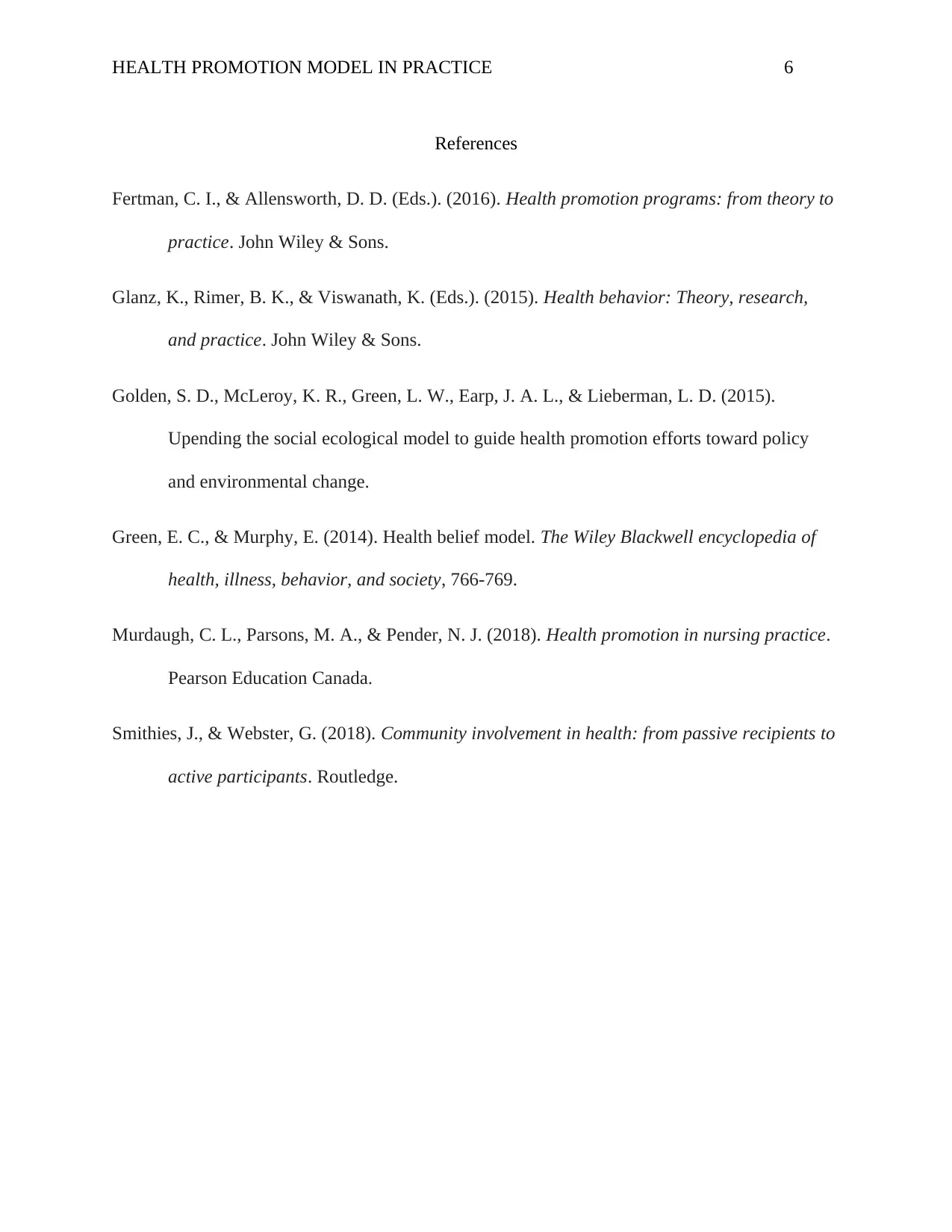
HEALTH PROMOTION MODEL IN PRACTICE 6
References
Fertman, C. I., & Allensworth, D. D. (Eds.). (2016). Health promotion programs: from theory to
practice. John Wiley & Sons.
Glanz, K., Rimer, B. K., & Viswanath, K. (Eds.). (2015). Health behavior: Theory, research,
and practice. John Wiley & Sons.
Golden, S. D., McLeroy, K. R., Green, L. W., Earp, J. A. L., & Lieberman, L. D. (2015).
Upending the social ecological model to guide health promotion efforts toward policy
and environmental change.
Green, E. C., & Murphy, E. (2014). Health belief model. The Wiley Blackwell encyclopedia of
health, illness, behavior, and society, 766-769.
Murdaugh, C. L., Parsons, M. A., & Pender, N. J. (2018). Health promotion in nursing practice.
Pearson Education Canada.
Smithies, J., & Webster, G. (2018). Community involvement in health: from passive recipients to
active participants. Routledge.
References
Fertman, C. I., & Allensworth, D. D. (Eds.). (2016). Health promotion programs: from theory to
practice. John Wiley & Sons.
Glanz, K., Rimer, B. K., & Viswanath, K. (Eds.). (2015). Health behavior: Theory, research,
and practice. John Wiley & Sons.
Golden, S. D., McLeroy, K. R., Green, L. W., Earp, J. A. L., & Lieberman, L. D. (2015).
Upending the social ecological model to guide health promotion efforts toward policy
and environmental change.
Green, E. C., & Murphy, E. (2014). Health belief model. The Wiley Blackwell encyclopedia of
health, illness, behavior, and society, 766-769.
Murdaugh, C. L., Parsons, M. A., & Pender, N. J. (2018). Health promotion in nursing practice.
Pearson Education Canada.
Smithies, J., & Webster, G. (2018). Community involvement in health: from passive recipients to
active participants. Routledge.
⊘ This is a preview!⊘
Do you want full access?
Subscribe today to unlock all pages.

Trusted by 1+ million students worldwide
1 out of 6
Related Documents
Your All-in-One AI-Powered Toolkit for Academic Success.
+13062052269
info@desklib.com
Available 24*7 on WhatsApp / Email
![[object Object]](/_next/static/media/star-bottom.7253800d.svg)
Unlock your academic potential
Copyright © 2020–2025 A2Z Services. All Rights Reserved. Developed and managed by ZUCOL.





